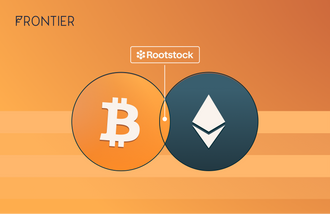
Bitcoin and Ethereum, they’re the two most notable crypto projects in this trillion-dollar market. But each of them serves a completely different purpose. At least that’s what most people think.
First, Bitcoin. Bitcoin, the decentralized cryptocurrency created in 2009 is seen as the – hard money of the internet. Secure. Digital. Decentralized. Second, Ethereum. Ethereum, the smart-contract blockchain created in 2015 is seen as the – decentralized internet on which applications are built. Programmable. Developer-friendly. Decentralized.
Bitcoin is the currency (on its own network) and Ethereum is the network (with its own currency ETH).
Yes, Bitcoin solved for money. But money is more than just currency. It’s:
- savings
- investing
- payments
And a whole lot more.
This is the difference between money as currency and money as finance.
Ethereum solves this through the use of – decentralized finance or DeFi technology. A financial system that is programmable and useful with decentralized applications using decentralized currency.
DeFi was seen as something limited to Ethereum and other smart-contract based blockchains like – Solana, Fantom, Avalanche, etc. But certainly not Bitcoin, the currency wielding hard asset that birthed the crypto movement.
But in a little known corner of the Bitcoin lies a sidechain (of Bitcoin) that’s making DeFi possible. Meet Rootstock or RSK.
What is Rootstock (RSK)?
Rootstock (RSK) is an open sidechain that is pegged to Bitcoin (BTC).
It is a Layer 2 solution that allows for smart contracts and other decentralized applications (dApps) to be built on top of Bitcoin. Rootstock is secured by the Bitcoin network, which provides it with a high level of security and reliability.
Like Ethereum has sidechains (like Polygon) that work like Layer 2 (like Arbitrum and Optimism), Rootstock works to make Bitcoin more – efficient and programmable.
It works like an open-source smart contract platform on the Bitcoin blockchain. Launched in 2018, Rootstock aims to expand the functionality of Bitcoin by enabling the execution of smart contracts, similar to those seen on platforms like Ethereum. By providing a platform for decentralized applications (dApps) and smart contracts, Rootstock intends to enhance Bitcoin's potential uses beyond its role as a digital store of value.
How does Rootstock work?
Sidechain
Rootstock operates as a sidechain, which means it runs in parallel to the Bitcoin blockchain.
It’s not that different from Bitcoin either. Rootstock is secured by a modified version of the Bitcoin mining algorithm. This algorithm ensures that the Rootstock network is secure and that transactions are processed quickly and efficiently. And it also means that assets can be transferred between Bitcoin and Rootstock.
Architecture
The architecture of Rootstock allows seamless integration between Rootstock and Bitcoin, allowing users to transfer BTC to the Rootstock sidechain and vice versa. When assets are transferred to Rootstock, they are locked in a contract on the Bitcoin blockchain. This contract ensures that the assets cannot be spent unless they are unlocked by a specific transaction.
When assets are transferred back to Bitcoin, they are unlocked and can be spent again. This is called the two-way pegging mechanism which ensures that the value and security of Bitcoin can be utilized within the Rootstock ecosystem, while also benefiting from the additional features provided by Rootstock.
Rootstock Virtual Machine
At the heart of Rootstock's functionality lies the Rootstock Virtual Machine (RVM). Similar to Ethereum's EVM (Ethereum Virtual Machine), the RVM enables the execution of smart contracts on the Rootstock platform. This compatibility allows developers to leverage their existing knowledge of Solidity, the programming language used in Ethereum smart contracts, to build and deploy decentralized applications on Rootstock. This interoperability opens up a world of possibilities for Bitcoin, enabling it to harness the power of programmable contracts.
How is Rootstock helping Bitcoin?

Rootstock seeks to address the limited nature of Bitcoin by adding smart contract functionality to the Bitcoin network. This means that developers can build decentralized applications on top of Bitcoin, making it more versatile and useful.
The addition of smart contracts to the Bitcoin network allows for the creation of decentralized applications. They enable developers to create applications that are more secure, transparent, and resistant to censorship.
The most significant benefit of Rootstock is that it is enhancing the functionality of Bitcoin without compromising its decentralized nature. Because Rootstock is a sidechain, developers can create smart contracts that utilize Bitcoin as an underlying asset while still retaining the security and reliability of the Bitcoin network.
Here are some benefits of Rootstock:
Scalability
Rootstock's sidechain architecture alleviates the scalability concerns that have plagued the Bitcoin network. By offloading smart contract execution to Rootstock, the main Bitcoin blockchain is relieved of the burden, resulting in faster transaction processing times and reduced fees.
Security
Rootstock utilizes the robust security of the Bitcoin network by relying on merged mining. Miners who participate in Bitcoin mining can simultaneously mine Rootstock blocks, ensuring that the Rootstock network is protected by the immense computational power securing Bitcoin.
Interoperability
One of the most significant advantages of Rootstock is its seamless integration with the Bitcoin ecosystem. Users can transfer bitcoins to the Rootstock sidechain and utilize them within Rootstock's smart contracts. This integration not only maintains the value of Bitcoin within the Rootstock ecosystem but also facilitates cross-chain compatibility.
Decentralization
Rootstock operates on a sidechain, which means that it is independent of the main Bitcoin chain. This enables the creation of dApps that are more decentralized and resistant to censorship. And the sidechain is governed by a decentralized community, which ensures that the platform is not controlled by any single entity.
Network Effect
Bitcoin, as the first and most widely recognized cryptocurrency, boasts a massive network effect and a substantial user base. By building on top of Bitcoin, Rootstock taps into this vast network, potentially driving the adoption of decentralized applications and smart contracts within the Bitcoin community.
Programmability meets usability
Rootstock (RSK) is an exciting development that is bringing programmability to Bitcoin, expanding its capabilities beyond being a mere store of value. This not only wasn’t possible before but was shrugged off by other blockchains like Ethereum.
By providing a platform for smart contracts and decentralized applications, Rootstock leverages Bitcoin's security and network effect while introducing enhanced scalability and interoperability. With Rootstock, Bitcoin stands to unlock a myriad of use cases, from DeFi to asset tokenization, enabling the Bitcoin ecosystem to evolve and adapt to the changing landscape of decentralized finance.
As Rootstock continues to develop and gain traction, the potential for Bitcoin's programmability becomes increasingly evident, opening doors to a new era of innovation and utility.
